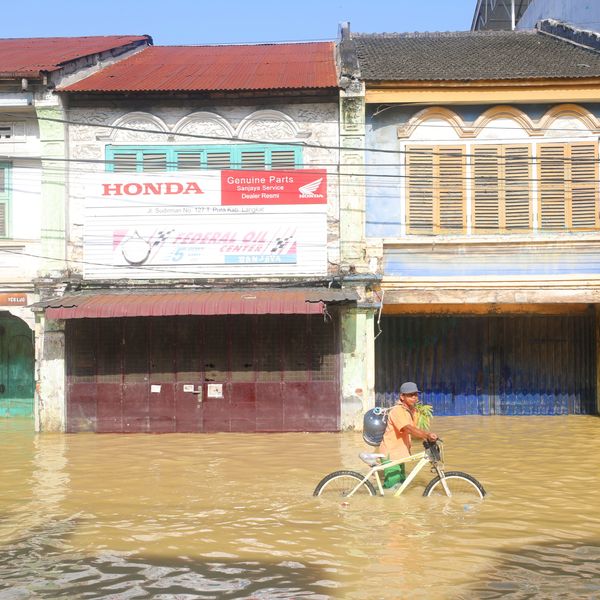Increase in Extreme Storms Causing 'Rapid Ozone Destruction'
Injection of water vapor makes ozone layer sensitive to global warming -- and geoengineering
Extreme summer thunderstorms are likely causing accelerated damage to the ozone layer over the United States, as the frequency and strength of storms continue to increase, according to a study released Thursday by the journal Science at Harvard University.
Scientists have previously known that strong storms pose a threat to the ozone layer, due to an effect known as water-vapor injections which project H2O high into the stratosphere where it doesn't belong; however, recent studies of storms have revealed that such 'injections' are reaching far higher and at greater capacity than thought possible, and are likely providing conditions for 'rapid ozone destruction.'
"It's the union between ozone loss and climate change that is really at the heart of this." The two are now "intimately connected.""...the rates of those reactions are governed mainly by temperature and the presence of water vapor. If, as expected, storm activity increases owing to global warming, the proportion of water in the stratosphere will increase, leading to accelerating destruction of stratospheric ozone -- and an increase in the amount of ultraviolet radiation reaching Earth," writes Nature news.
James G. Anderson, an atmospheric scientist at Harvard and the lead author of the study, said the findings were enough to cause alarm -- considering the increasing rate of extreme storms tied to climate change.
"We were shocked," says Anderson. "Standard, run-of-the-mill Midwestern thunderstorms are far more capable of injecting water vapour into the stratosphere than we once thought."
"This problem now is of deep concern to me," Anderson stated. "I never would have suspected this."

The study also raises questions about geoengineering -- the concept of manipulating the environment to mitigate climate change. One method of geoengineering currently being considered would involve pumping sulphate aerosols into the stratosphere to reflect sunlight back into space and cool the planet. But sulphate particles also act as catalysts for ozone-destroying reactions, so such a scheme could speed the reactions. "The worst cocktail you can think of is to inject a combination of sulphur and water into the stratosphere, and that is exactly what would be happening," says Anderson. "Nature would be injecting the water, and humans would be injecting the sulphates."

An Urgent Message From Our Co-Founder
Dear Common Dreams reader, The U.S. is on a fast track to authoritarianism like nothing I've ever seen. Meanwhile, corporate news outlets are utterly capitulating to Trump, twisting their coverage to avoid drawing his ire while lining up to stuff cash in his pockets. That's why I believe that Common Dreams is doing the best and most consequential reporting that we've ever done. Our small but mighty team is a progressive reporting powerhouse, covering the news every day that the corporate media never will. Our mission has always been simple: To inform. To inspire. And to ignite change for the common good. Now here's the key piece that I want all our readers to understand: None of this would be possible without your financial support. That's not just some fundraising cliche. It's the absolute and literal truth. We don't accept corporate advertising and never will. We don't have a paywall because we don't think people should be blocked from critical news based on their ability to pay. Everything we do is funded by the donations of readers like you. Will you donate now to help power the nonprofit, independent reporting of Common Dreams? Thank you for being a vital member of our community. Together, we can keep independent journalism alive when it’s needed most. - Craig Brown, Co-founder |
Extreme summer thunderstorms are likely causing accelerated damage to the ozone layer over the United States, as the frequency and strength of storms continue to increase, according to a study released Thursday by the journal Science at Harvard University.
Scientists have previously known that strong storms pose a threat to the ozone layer, due to an effect known as water-vapor injections which project H2O high into the stratosphere where it doesn't belong; however, recent studies of storms have revealed that such 'injections' are reaching far higher and at greater capacity than thought possible, and are likely providing conditions for 'rapid ozone destruction.'
"It's the union between ozone loss and climate change that is really at the heart of this." The two are now "intimately connected.""...the rates of those reactions are governed mainly by temperature and the presence of water vapor. If, as expected, storm activity increases owing to global warming, the proportion of water in the stratosphere will increase, leading to accelerating destruction of stratospheric ozone -- and an increase in the amount of ultraviolet radiation reaching Earth," writes Nature news.
James G. Anderson, an atmospheric scientist at Harvard and the lead author of the study, said the findings were enough to cause alarm -- considering the increasing rate of extreme storms tied to climate change.
"We were shocked," says Anderson. "Standard, run-of-the-mill Midwestern thunderstorms are far more capable of injecting water vapour into the stratosphere than we once thought."
"This problem now is of deep concern to me," Anderson stated. "I never would have suspected this."

The study also raises questions about geoengineering -- the concept of manipulating the environment to mitigate climate change. One method of geoengineering currently being considered would involve pumping sulphate aerosols into the stratosphere to reflect sunlight back into space and cool the planet. But sulphate particles also act as catalysts for ozone-destroying reactions, so such a scheme could speed the reactions. "The worst cocktail you can think of is to inject a combination of sulphur and water into the stratosphere, and that is exactly what would be happening," says Anderson. "Nature would be injecting the water, and humans would be injecting the sulphates."

Extreme summer thunderstorms are likely causing accelerated damage to the ozone layer over the United States, as the frequency and strength of storms continue to increase, according to a study released Thursday by the journal Science at Harvard University.
Scientists have previously known that strong storms pose a threat to the ozone layer, due to an effect known as water-vapor injections which project H2O high into the stratosphere where it doesn't belong; however, recent studies of storms have revealed that such 'injections' are reaching far higher and at greater capacity than thought possible, and are likely providing conditions for 'rapid ozone destruction.'
"It's the union between ozone loss and climate change that is really at the heart of this." The two are now "intimately connected.""...the rates of those reactions are governed mainly by temperature and the presence of water vapor. If, as expected, storm activity increases owing to global warming, the proportion of water in the stratosphere will increase, leading to accelerating destruction of stratospheric ozone -- and an increase in the amount of ultraviolet radiation reaching Earth," writes Nature news.
James G. Anderson, an atmospheric scientist at Harvard and the lead author of the study, said the findings were enough to cause alarm -- considering the increasing rate of extreme storms tied to climate change.
"We were shocked," says Anderson. "Standard, run-of-the-mill Midwestern thunderstorms are far more capable of injecting water vapour into the stratosphere than we once thought."
"This problem now is of deep concern to me," Anderson stated. "I never would have suspected this."

The study also raises questions about geoengineering -- the concept of manipulating the environment to mitigate climate change. One method of geoengineering currently being considered would involve pumping sulphate aerosols into the stratosphere to reflect sunlight back into space and cool the planet. But sulphate particles also act as catalysts for ozone-destroying reactions, so such a scheme could speed the reactions. "The worst cocktail you can think of is to inject a combination of sulphur and water into the stratosphere, and that is exactly what would be happening," says Anderson. "Nature would be injecting the water, and humans would be injecting the sulphates."


